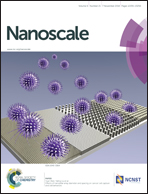Do dislocations act as atomic autobahns for oxygen in the perovskite oxide SrTiO3?
Abstract
The transport properties of edge dislocations comprising a symmetrical 6° [001] tilt grain boundary in weakly acceptor-doped SrTiO3 were investigated by means of various experimental and computational techniques. Oxygen transport along the dislocation array was probed by means of 18O/16O exchange experiments under (standard) oxidising conditions (pO2 = 5 × 10−1 bar) and also under reducing conditions (pO2 = 7 × 10−22 bar) at T = 973 K. In both cases, isotope profiles obtained by Secondary Ion Mass Spectrometry (SIMS) indicated no evidence of fast diffusion along the dislocation array. Charge transport across the dislocation array was probed in equilibrium electrical conductivity measurements as a function of oxygen partial pressure, 10−23 ≤ pO2/bar ≤ 1 at temperatures of T/K = 950, 1050, 1100. A significant decrease in the conductivity of the bicrystal (relative to that of a single crystal) was observed under oxidising conditions, but not under reducing conditions. These studies were complemented by static lattice simulations employing empirical pair-potentials. The simulations predict, that the tilt boundary comprises two types of dislocation cores, that the formation of oxygen vacancies is energetically preferred at both cores relative to the bulk, and that the migration of oxygen ions along both cores is hindered relative to the bulk. Combining all results and literature reports, we present a comprehensive and consistent picture of the transport properties of dislocations in SrTiO3.



 Please wait while we load your content...
Please wait while we load your content...